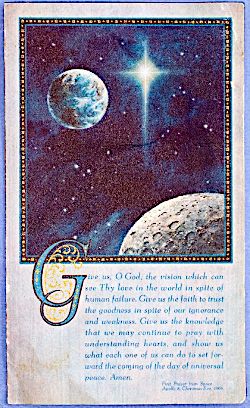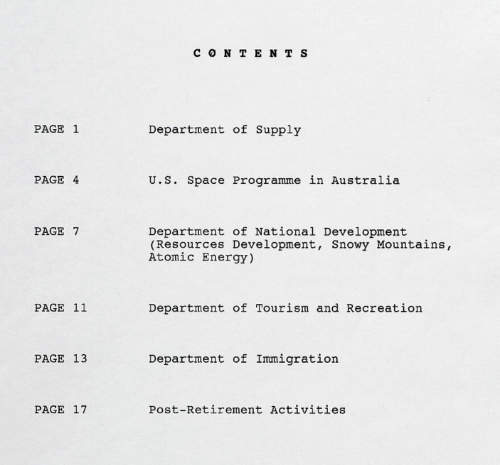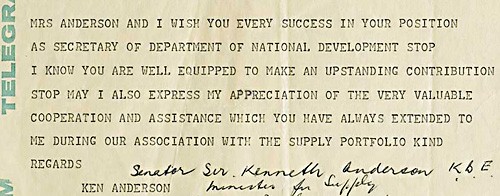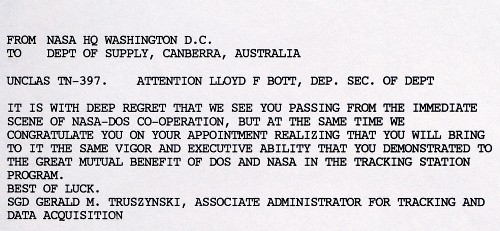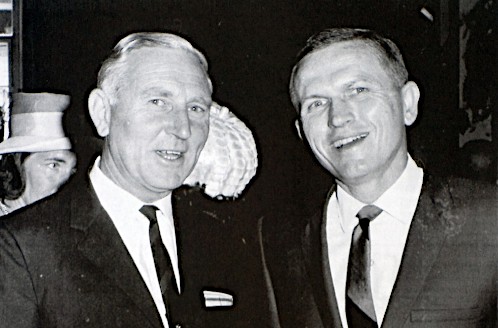
Lloyd Bott with Frank Borman
March 1966.
Lloyd Bott – Some Post-War Memories
 |
Lloyd Bott with Frank Borman |
Extracted from
SOME POST-WAR MEMORIES OF LLOYD BOTT C.B.E. D.S.C.
FIRST WRITTEN 1986
REVISED 1995
When I left the Navy in 1946 I returned to the Department of Supply (or Munitions, whatever it was called at the time) and continued my studies for the Degree of Bachelor of Commerce at the Melbourne University, which I had abandoned in 1939.
In this regard I think it’s very interesting to compare the pre-war and post-war University. Pre-war there were substantially smaller numbers, more personal associations, plenty of room to move and lovely Wilson Hall. Afterwards there were thousands of students, all spare areas of land being covered with buildings, Wilson Hall destroyed by fire, etc.
It never had the same campus environment nor feeling. There was a pronounced change.
Department of Supply
Back in Department of Supply one was reminded of the quality of the people there. Sir John Jensen, a man of great vision and quality; Cec. Gillan – a man who didn’t get into a flap about things; Jim Bradburn, my mentor, a brilliant man with the common touch – possibly the best brain I ever came across, a lovely man. Subsequently Harold Breen became Permanent Head, in some respects a dour man and who some possibly thought was hard but he was a very fair man with a deep feeling for the interest of those who worked in the Department – a man of principle and real character for whom I had the deepest affection. When Supply and Defence Production (Munitions) joined together we had Frank O’Connor a much-loved, delightful man. He was followed as Permanent Head by John Knott from whom I learned a lot about the value of communicating with people.
The Department of Supply was a wonderful training ground. We operated the Government Munitions and Aircraft Factories employing thousands of people, the Defence Scientific Establishments and the Woomera Rocket Range, the Defence contracting organisation, the Government Stores and Transport Operations. And during my final years with Supply I directed the NASA (National Aeronautic and Space Administration of U.S.A.) projects in Australia. For a time the Australian Antarctic Division also became a responsibility of Department of Supply.
A year in England
It was my home experience, my war experience and associations within Department of Supply that helped form my philosophies of the dignity of man and the dignity of work. I was very fortunate in Supply as I was selected as a potential top executive and sent to England to spend a year with the U.K. Ministry of Supply to broaden my education and experience. Gwen, I and Michael (then aged 3) left Australia on the Stratheden in December, 1948 and returned in February , 1950, on the Himalaya. (It is interesting that on the trip home I won the Deck Quoits with Jack Hotblack – a P. & O. Director and Gwen played Deck Tennis with Lord Inchcape, also a P. & O. Director.)
One of the interesting things I did in that year was to visit Germany to see how the Australian Reparations team was faring – as war reparations we were bringing selected items of plant to Australia. Actually, at one factory I visited, they were waiting for us to take out the old plant so they could instal brand new plant being supplied by the United States under Marshall Aid. So, apart from a 52 or 56-hour week, the Germans had new modern plant to assure their economic recovery and indeed, economic supremacy.
Altogether the year in the British Ministry of Supply was very rewarding with close association being made with top officials in policy areas and with the Permanent Secretary Sir Archibald Rowlands (particularly in relation to his appearance before the Parliamentary Public Accounts Committee which we did not have in Australia at that time). I visited many Government and private factories.
Mention of Sir Archibald reminds me that I met him at a Garden party at Buckingham Palace. He had struggled to get into his morning suit (he’d put on weight since he had bought it) and he commented on how immaculate I had presented myself. As he had assumed, I hired my grey topper and morning suit from Moss Bros. who specialise in such hirings. At the Garden Party Gwen and I were also proud to shake the hand of Winston Churchill. It was a warm day and we had a lovely time. I recall that as we were leaving a young lady hurried over and spoke with us. It was Marie Millington-Drake who had been a boating wren at Dartmouth. It was a very pleasant surprise. Her father, Sir Eugene Millington-Drake was the British Ambassador in Uruguay at the time of the Battle of the River Plate during World War 2. I learned later from Marie’s brother who visited Canberra from time to time that Marie had married an Italian Count and unfortunately she had died at an early age.
Gwen was fortunate to see England as it then was. Of course, there was still rationing and queueing for food but there were good old English bus conductors and very few visitors. Gwen would look at the papers to see where the Royal family engagements were and, if she could make it, would be one of a very small number to see them. We had no trouble booking for the Ballet and could visit tourist areas comfortably. Gwen recalled this on a recent visit to Cockington, a tiny thatched village near Torquay. When Gwen had gone there in 1949 she was the sole visitor, and had in fact been invited into a cottage centuries old, but now we could barely move for hundreds of people and buses by the dozen. It is a changed world with all the people travelling.
Return to Australia 1950
After my return to Australia in February, 1950, I became more and more involved in the policy area. Among other things, I was Commonwealth Director on the Board of Nitrogen Fertilisers Pty. Ltd. which marketed sulphate of ammonia and urea. The other directors were from B.H.P., I.C.I., A.N.Z., and the Gas & Fuel Corporation. We each produced the fertiliser in our own plants, some such as B.H.P. getting the sulphate of ammonia as a by-product from its steel works. I initiated the sale to industry of our Sulphate of Ammonia plants and also our Ball Bearing Factory at Echuca.
Then, about the time of the Korean War, we built a new Explosives Filling Factory at St. Marys, an outer suburb of Sydney. This was the biggest new munitions establishment we have built since World War 2. I frequently chaired the monthly meetings between architects, building contractor and our technical and financial staff. As with most big building projects, this had many hassles but it was finally completed as a first-class establishment.
And of course I had an interest in the Woomera Rocket Range which was continually being developed and upgraded and expanded to meet new weapons requirements. It was all very stimulating.
Possibly the next big project in which I was deeply involved was the purchase of a Fighter Aircraft for the R.A.A.F. to replace the Sabre. I was part of the mission led by the then Chief of Air Staff , Sir Frederick Scherger, which visited Europe and U.S.A. to recommend a replacement aircraft. We were away about 16 weeks I think. “Scherg” was a tremendous fellow to travel with. He was a marvellous man.
The Australian Mission which recommended purchase of Mirage fighter aircraft, 1958. Left to right: Ian Fleming, Air Marshal Scherger, Group Capt. Gel Cuming, Lloyd Bott, Wing Commander Alan Hodges, Serge Dassault. |
Our recommendation for the Mirage was finally accepted and I headed the very competent team responsible for all the contracting arrangements. This involved many weeks from time to time in France and we developed very close relationships with the Dassault Company which made the Mirage. Their officers were top quality people, very intelligent logical thinkers and I have a great respect for them. I believe that the Mirage project was the most successful and best negotiated major defence project ever undertaken by the Australian Government.
I am sure that my wartime associations with the French Resistance helped develop the trust so necessary in a big project like the Mirage. The Dassault officers helped me significantly in my visits to Brittany from time to time.
I also had many visits to France because of my Woomera connections. I used to attend ministerial meetings of the European Launcher Development Organisation (E.L.D.O.). We were arguing to them that the planned European satellites should be launched from Woomera but in the event E.L.D.O. elected for French Guyana. In retrospect, I’m satisfied they made the right decision as we would have been embarrassed trying to keep Woomera at the ready for all these years. In this respect it is to be noted that the Giotto probe which so successfully intercepted Comet Halley on 13th March, 1986 and observed at very close range the comet nucleus and transmitted the pictures back to earth, was launched from French Guyana on 2nd July, 1985.
One big pleasure arising from all the visits to France was that it enabled me to maintain some of the old wartime associations.
US Space Programme
Another eventful part of my Supply life came with the advent and development of the U. S. space programme. In the 1960s we started off assisting N.A.S.A. with some of our radar- tracking facilities at Red Lake at Woomera. This developed into building of tracking stations for N.A.S.A. at Muchea (near Perth) for Mercury then a bigger station at Carnarvon W.A. for Gemini and three very big stations in the Australian Capital Territory at Tidbinbilla, Orroral Valley, and Honeysuckle Creek for Deep Space, communication and other scientific satellites, and for manned flight to the moon. This was an exciting period and I was fortunate to be the chief co-ordinator – managing director if you like – of all N.A.S.A. activities in Australia.
I had frequent visits to N.A.S.A. facilities on mainland U.S.A. and also I visited Kowhai in Hawaii and at Bermuda. I’m sure the Americans expected that responsible people connected with their programme would not treat it as just another technical job but to be deeply involved personally. As the programme was the biggest thing happening in the world at the time this was certainly how I felt about it as also did the Station Managers and their staff.
In the series of Gemini flights one of the important projects was the rendezvous of 2 spacecraft in space. This had to be accomplished before we could land on the lunar surface in the Apollo programme then take off and link up again with the Command Module which would be orbiting around the moon.
On December 15th and 16th, 1965, Wally Schirra with Tom Stafford in Gemini VI achieved the rendezvous with Frank Borman and Jim Lovell in Gemini VII. I had met Wally many times before but after the rendezvous flight, Wally and Frank and their wives came to Australia on a goodwill mission and to thank our tracking stations for the support they had given the flights. I accompanied them around Australia and I recall really well the cavalcade through Melbourne which Gwen and I were in and we took them to Government House to meet Sir Edmund Herring, the acting Governor and to Harold Holt’s house to meet the Prime Minister and to Parliament House to see the Premier Sir Henry Bolte. I recall also an enormous crowd at a large Grace Bros. complex in Sydney.
Apollo 8 holds a particular significance for me. This was the first time man had circled the moon – and I have a copy of the famous picture of the earth taken from over the moon and it’s signed by the three Astronauts Frank Borman, Jim Lovell and Bill Anders.
During that Apollo 8 flight the first prayer came from space and Frank Borman, a fine Christian gentleman, who said the prayer, included it on his Christmas card which I received from him the following year. The prayer from Space, Apollo VIII, Christmas Eve, 1968 reads as follows :–
“Give us, O God, the vision which can see Thy love in the world in spite of human failure.
Give us the faith to trust the goodness in spite of our ignorance and weakness.
Give us the knowledge that we may continue to pray with understanding hearts, and show us what each one of us can do to set forward the coming of the day of universal peace. Amen.”
During the Apollo VIII flight my son Stephen was working at Tidbinbilla Tracking Station, so he also had some small part in the historic mission.
I was fortunate to meet many astronauts on my visits to the United States. Additional to Wally Schirra, Frank Borman, Jim Lovell and Bill Anders, there were Deke Slayton, Al Shepard, Tom Stafford, Walt Cunningham and Philip Chapman, the only Australian in the astronaut team. In Australia, I also met Al Shepard, David Scott and Pete Conrad. Gwen had the pleasure on one occasion of driving David out to the Melbourne Airport. They were generally speaking, fine representatives of the United States.
It was a great experience to be part of it all and I thoroughly enjoyed it and their trust and faith in me. I suppose the highlight of it all was to be present at the launch of Apollo XI on July 16th, 1969, as a guest of N.A.S.A. and the Vice-President of the United States. I have a very nice certificate to that effect signed by Vice President Agnew.
It was a tremendous occasion witnessed by some hundreds of thousands of people at Cape Kennedy as it then was. (It seems now it has reverted to its old name Cape Canaveral.) The atmosphere was electric, full of drama, excitement and expectation as we waited for the rocket motors to ignite to launch man on his mission to set foot on the moon for the first time. It was a great thrill to be there to see the vehicle on its way.
After the launch we were flown by V.I.P. aircraft to Houston, Texas where is located the Command Center for manned Spaceflights. I was present in the Mission Control Center when Apollo XI , after orbiting the earth to check out its systems, was given the all-clear to proceed to the moon. Whilst at the center, I had a chat with my old friend Christopher Kraft who was the Director of Operations then at the Manned Space Centre and the man in charge of the mission from the ground. It was an experience to be there where the center of action was.
The Minister and I then departed for home. After spending a night at Honolulu we proceeded to Australia and I was out at Honeysuckle Creek station in the A.C.T. to see the landing on the moon. Actually it had been programmed that Honeysuckle Creek would be the back-up station but in the event there were some difficulties in communication from the U.S. station and Honeysuckle Creek, in fact, was the prime station for that vital part of the mission. So I had the tremendous, unique experience of seeing the lift-off, of being at Houston when the command to proceed to the moon was given and being at our Australian station to see the landing on the moon which must rank as one of the greatest feats ever performed by man.
The large C.S.I.R.O. 210 foot radio telescope at N.S.W. played an important part in this mission. Parkes had made a tremendous amount of technical knowledge available to N.A.S.A. to assist them in the development of their large dishes.
That was really the end of my days with Dept. of Supply as 3 weeks later, in August, 1969, I was appointed Secretary of the Department of National Development. This was another tremendous experience.
. . . . . . . . . . . . . . . . . . . . . . . . . . . . . . . . . . . . . . . . . . . . . . . .
[The NASA-related section ends here, but see the PDF file linked below for the full document.]
Download Lloyd Bott’s full Post War Memoirs as a 4.7MB PDF file. With grateful thanks to Michael Bott, and to Ken Sheridan for photographing the pages. Image alignment and assembly by Colin Mackellar. |
The Minister for Supply Senator (later Sir) Ken Anderson sent this telegram to Lloyd Bott on his leaving his position as Deputy Secretary of Supply, in 1969. |
Gerald M. Truszynski, Associate Administrator Office of Tracking and Data Acquisition, sent this TWX on September 25th 1969. |

